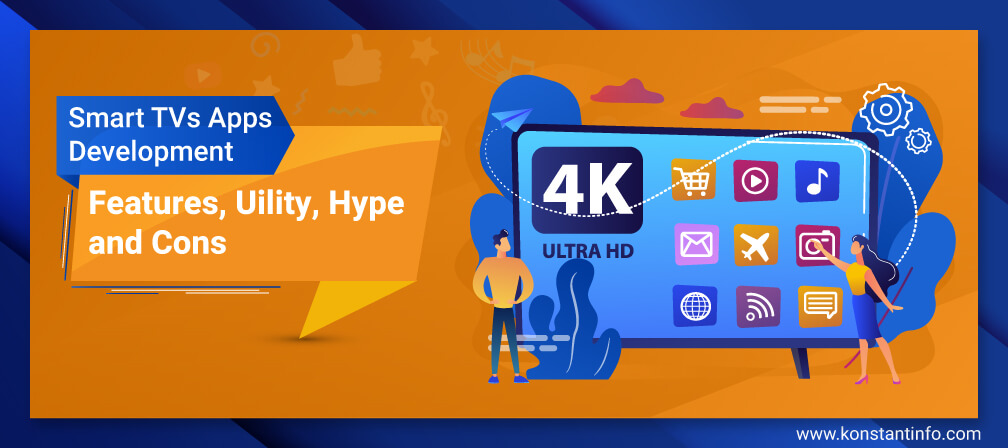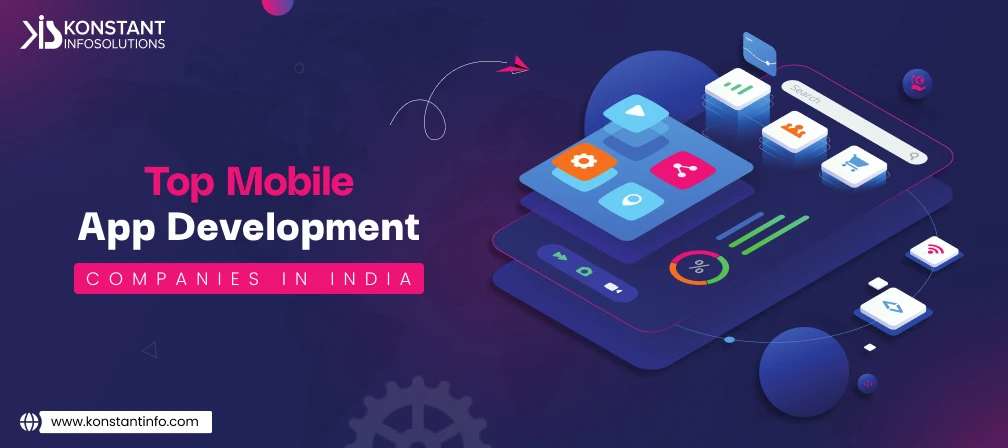The increasing number of Smart TVs encourages app development business, ensuring seamless connectivity across various devices and platforms. Big brands launch their proprietary applications to connect with their potential viewers with great ease. But entrepreneurs engaged in offering third-party services still experience difficulties in reaching out to their targets.
IT Companies align with advertisers and broadcasters to come up with applications for Smart TVs to ensure that they cater to customers on every platform. If you just bought a smart TV, you will require applications to make it work. Smart TVs offer numerous internet-connected services like media streaming, apps, games and web browsing. ‘Smart TV App development services’ promote, enhance visibility and help reaching out to target audience by videos-on-demand or live-streaming.
Why are Smart TV Apps in demand?
- Videos-on-Demand – It helps to select the videos you wish to watch at any time and eventually bridges any gaps between the content provider and consumer without time constraint.
- Live Streaming – It shows any show that is live/on-air to the audience.
- TV Commerce – Businesses get a chance to promote their products through TV.
- Browse Information – TV helps search for information like weather, news, and latest trends on the web.
- Gallery Applications – Businesses get to showcase their products and services to an audience, even if they are not willing to sell right away.
- App Appearance – The look and feel of an application seem better on TV instead of any handheld device.
What can you do with your Smart TV?
- Android TV applications capture users browsing behaviour and display relevant
- Smart TV apps allow users to connect across the globe via the social web. They can share tasks, lists and view their favourite content on the TV screen.
- If users fail to understand the functionality, they can rate and review the apps on their smart TV.
- Self-help guides are available in multiple languages and help fix issues without making phone calls and waiting in long queues.
Smart TV App Examples
Television brands incorporate one-to-many platforms integrated into their apps. Few brands that people like to find:
- Amazon Fire TV app development – Toshiba, Element, Westinghouse
- Roku TV app development – Hitachi, TCL, Hisense/Sharp, Insignia, Philips, Element
- Android TV app Development – Element, LeECO, Sony, Sharp, Toshiba, Westinghouse
- NetTV App Development – Philips
- VEWD App Development – Sharp
- WebOS App Development – Life’s Good (LG)
- Samsung Smart TV App Development – Tizen Smart Hub
- Chromecast App Development – Haier, JVC, LeECO, Philips, Polaroid, Sharp, Skyworth, Soniq, Sony, Toshiba
Many more platforms offer apps for Smart TVs: Apple, Vizio, LG, Panasonic etc.
Smart TV Apps Development
Every Smart TV platform differs in its offerings – to process games, media applications, and utility applications. It uses frameworks and techniques for mobile operating systems (iOS, Android etc.). ‘Smart TV platforms’ use individual SDKs, guidelines and the best available technologies that produce the first-rate experience for users.
What to consider?
Follow these tips to create high-quality products and increase user experience, making them comfortable and intuitive.
- ‘Smart TV Platform‘ – Essentially ‘Smart TVs’ run on Android or iOS with different screen resolutions, processing power etc. ‘Smart TV’ vendors like Samsung keep extension libraries that enable them to enhance applications with additional features.
- ‘Smart TV’ Developers – Select the skilled developers according to their experience level. Analyze their portfolios; identify the platform requirements; check previous client reviews, company’s pricing policy, and suggested deadlines for ‘Smart TV app development’;
- Size of Screen – Developers need to consider screen sizes, distances and angular while developing an application for Smart TV. App resizing to fit the size of the TV, the readability of text, the colour palette – day/night modes and halo effect, and the horizontal alignment are three factors to consider while creating a ‘Smart TV’ application.
- Remote Control – A ‘Smart TV’ design includes designing its remote control, facilitating back and forth navigation. The features are platform-specific and are often limited to the areas of distribution. E.g. Apple offers Siri remote for a limited number of countries – Australia, Canada, Germany, Japan, France etc. The Android/iOS ‘Smart TV apps’ must respond to all types of devices for which they exist.
- Navigation – The back and forth navigability should be seamless. The vocabulary should be simple. Ok indicates Enter, double vertical lines indicate a pause, and a red dot indicates to stop. Getting started and shutting off should be easier without unnecessary screens.
- Focus State – It is an essential part of a smart TV that helps users to select and click on an appropriate element without the fear of getting lost and losing time.
- Test on digital devices – The smart TV app must follow the SDLC process – from planning to maintenance. It becomes essential to try it on a phone device before running it on actual TV before the official launch.
Features to Incorporate in Smart TV Apps
‘Smart TV’ Brands sort features with platforms and integrates accordingly:
- SmartShare (LG)
- SmartView (Samsung)
- Miracast
- Screen Sharing
- Web browsing
- Social Media
- Play Games
- Skype Friends and Family
- Watch Home Videos and Create Photo Slideshows
- Get Apps
- Media Streaming Apps like YouTube, Netflix, Spotify, Prime Video, BBC Sports, Google Play Movies
- PICTURE QUALITY
- QLED Display
- Patch Wall
- Display in 4K Resolution – for better visuals
- NTSC colour space
- DCPI-3 – infinite contrast, powerful luminance, colour rendering
- Dolby Vision – Visual appeal
- HDR 10+ technology – Optimizes content frame by frame, boosts colour saturation, details brilliant blacks and colour making
- Hybrid Log-Gamma (HLG) – To display high-quality visuals, extended colour gamut, the high-dynamic range for viewing the broadcast.
- Compatibility with DLNA, Miracast, Apple AirPlay 2 (Varies according to the platforms and models)
- It supports various AI-powered voice assistants like Google Assistant, Alexa, Bxby etc. (Varies according to the platforms and models) handsfree.
- 192 Zone Full Array Local Dimming
- 120Hz Refresh Rate with Reality Flow
- Horizon Display – Bezel-less design
- Vivid Picture Engine
- MI Quick Wake
- Stereo Speakers
Additional Points to Consider
- Some Android/iOS apps, content or features are not available across all countries. They are subject to availability.
- Users need a Google Account to access certain advertised features.
- Google, Google TV, YouTube, Google Play, Chromecast built-in are registered trademarks of Google LLC.
- Apple, the Apple logo, and Apple TV have registered trademarks of Apple Inc.
- Home screen design and features of Smart TVs vary by country.
- Apple TV apps are available via automatic or manual software update on Sony Bravia TV. Such updates are available on select models.
- Dolby Atmos, Dolby, Dolby Vision, and the double-D symbols are registered trademarks of Dolby laboratories.
- Netflix offers 4K ultra high definition availability according to the subscription plan – device capabilities – internet service – availability of content.
- Controllable device and feature depend on country and devices.
- Apple and related marks/logos are registered trademarks of Apple inc.
- Actual TV design and features vary by region.
- Sony and Bravia are registered trademarks of Sony Corporation.
Challenges: Hype and Extra Costs
Smart TV’s and their applications are compelling, but there are costs, hype and considerations surrounding them:
- ‘Smart TV’ platforms make many channels accessible, but these often require monthly subscriptions or pay-per-view fees. All that glitters is not always gold. There is a price to it. Your willingness to pay extends better options.
- The brand/model of the Smart TV influences the services and failures that you can access like similar core services – Netflix, Pandora, Google, Vudu, Hulu etc. Other apps are not accessible on some Smart TV platforms. The iOS Smart TV users must have an Apple TV box for accessing iTunes to stream audio and video content.
Conclusive: Why should you create Smart TV Apps?
Smart TV Apps can steer your mobile app development to the next level, as these are highly volatile and gives an excellent way to reach target audiences. We are adept in creating premium Smart TV Applications with persuasive design, scalable to market demand, empower companies with transformative solutions and data-driven insights. Our offerings include:
- Smart TV App Design
- Smart TV App Development
- Application Porting To Smart TV
- Smart TV App Maintenance and Support
If you are ready to shift the mindset and get the most out of the innovations, reach out to Konstant!
About Author
Neeti Kotia is a technology journalist who seeks to analyze the advancements and developments in technology that affect our everyday lives. Her articles primarily focus upon the business, social, cultural, and entertainment side of the technology sector.



